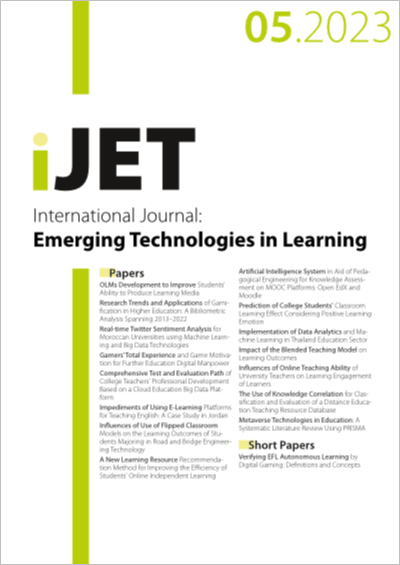Impact of the Blended Teaching Model on Learning Outcomes
DOI:
https://doi.org/10.3991/ijet.v18i05.37997Keywords:
BOPPPS; PAD Class; blended teaching model; learning outcome; ANOVA; independent sample t-test; paired sample t-testAbstract
Blended teaching and other information teaching models promote a new type of teaching revolution and enhance the interaction and communication among teachers and students. However, most colleges and universities still adopt the traditional teaching model where students’ learning efficiency and quality are relatively low with teachers’ spoon-feeding delivery. The Bridge–Objective–Bridge–Pre-assessment–Participatory Learning–Post-assessment–Summary (BOPPPS) model advocates showing students clear learning objectives in leaning to form a learning objective-oriented model. The Presentation–Assimilation–Discussion (PAD) Class is conducive to cultivating learners’ high cognitive levels; in the presentation session, teachers simply refine and explain the framework and key points to help learners build a knowledge network. Based on BOPPPS and PAD Class models, a 15-week blended teaching experiment was conducted in the Computer Technology Translation course in Harbin Normal University of China. Results show that the significant p-value corresponding to the t-value of the pretest scores of control and experimental groups is 0.255, greater than 0.05, which is in line with the basic premise of this teaching experiment; the mean values of the posttest scores of students in the experimental and control groups of the paired-sample t-test are significant at 1% and 10% significance levels, compared with the mean values of pretest scores, respectively; in the traditional teaching model, female students tend to demonstrate more learning advantages than male students, whereas no difference is observed in the learning outcomes between males and females in the experimental group. Thus, the adoption of BOPPPS and PAD Class models can enhance the learning outcomes of males and females. Our findings provide new ideas and methods for deepening the development of the theoretical basis of PAD Class, expanding the perspective and application of BOPPPS and improving students’ learning enthusiasm and classroom participation effectively.
Downloads
Published
2023-03-07
How to Cite
Hou, J., & Xue, J. (2023). Impact of the Blended Teaching Model on Learning Outcomes. International Journal of Emerging Technologies in Learning (iJET), 18(05), pp. 192–202. https://doi.org/10.3991/ijet.v18i05.37997
Issue
Section
Papers
License
Copyright (c) 2023 Jie Hou, Junjie Xue

This work is licensed under a Creative Commons Attribution 4.0 International License.



